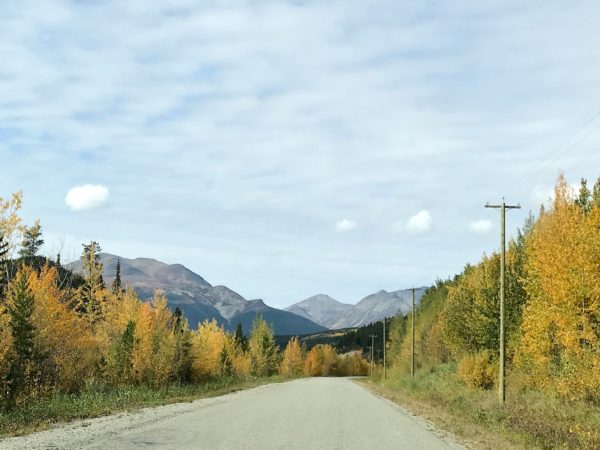
There are only two roads through British Columbia that will get you to or from Alaska – the Alaska Highway and the Cassiar/Yellowhead Highways. We came north on the first one, so we headed south on the Cassiar.
The Cassiar Highway is a relatively remote, 725-km (450-mile), paved, narrow, two-lane road through the Cassiar Mountains connecting Watson Lake (pop 1600) to Kitwanga (pop 400). The road mostly follows the river valleys and we were always within view of lakes and mountains of various shapes and sizes. Still, there were hints everywhere that there was more we weren’t seeing… occasional, brief glimpses between the trees of high, snow-covered peaks and avalanche signs everywhere. Also, heli-ski operations in settlements like Bell II (pop a handful plus seasonals) and a brochure for Provincial Parks with glorious mountain photos and instructions for how to access them, by air. Hmmmm…
Nonetheless, we found the drive to be quite pretty, imagined what we couldn’t see from where we were, and enjoyed a few remote campsites near lakes and rivers with great mountain views.
And then, there were the surprises…
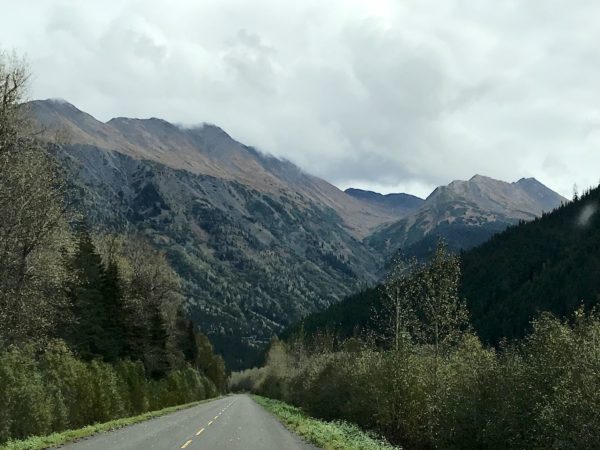
It was about 400 km (250 miles) south of Watson Lake where we started noticing changes… The first thing we noticed was the less colorful foliage, then more deciduous trees, then fewer black spruce, then no black spruce at all. The transition from boreal forest to an interior forest was like a big fat (about 10-km (6-mile)) line. And with that, we were out of the familiar boreal forest we’d been traveling through since we left Edmonton in May.
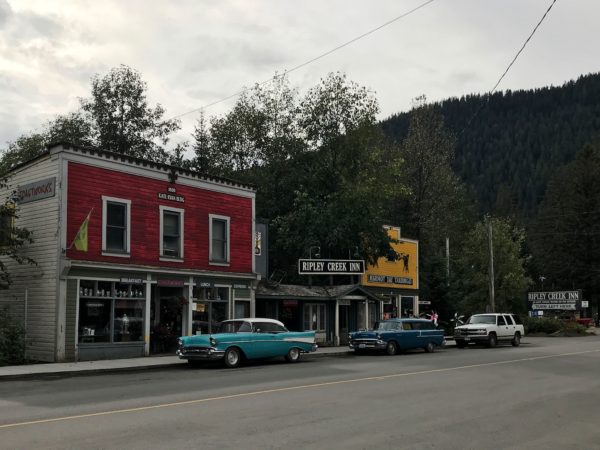
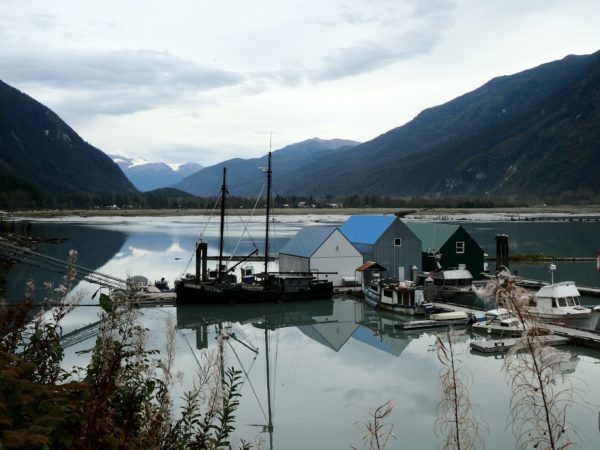
We took a side trip to Stewart, BC (pop 400). Situated at the end of the road (yup, another one…) and the end of the Portland Canal, a 70-mile fjord, and totally surrounded by mountains and glaciers, Stewart is a small yet busy commercial shipping port with active mining and lumber industries, and just a bit of tourism. It is a very cool town – ‘a real mining town – and no cruise ships,’ as one local resident told us. The town has a colorful history dating back to the late 1890’s when the Stewart brothers established the town and hyped yet-to-be-found gold strikes. They shrewdly marketed the claims to investors who provided funding to build the town and find the ore. Their fake-it-til-you-make-it approach made the town more sensitive to boom and bust cycles related to stock market crashes when funding evaporated as well as two world wars when men and mining evaporated into the military. The population ranged between 10,000 and 17 over the course of 40 years. Gold was finally found in 1919 at the Premier Mine, which ran until the 1950s. In the meantime, a couple of other mines were established a little farther out which are still producing, and the population has been relatively stable (400) since then. The largest gold stores found in British Columbia, being mined at hundreds of sites accessible only by helicopter, are just north of Stewart, in the Cassiars…
Today, downtown Stewart is a mix of businesses, stores, small hotels and restaurants, and a few historic structures that serve as reminders of its past. Hanging in town on a rainy Thursday night, we noticed people – locals and tourists – in and out of every establishment. On the edge of town, the IVS Okudogo, a bulk cargo ship sailing under the Singapore flag, was loading at the deep water dock – ore from trucks – for shipment to China. In the small space between the town and the port, bald eagles were posing and hunting over the estuary at low tide along with a variety of geese and ducks.
At Stewart’s visitor info center, we ran into our friends Dolores and Alejandro. Hailing from Argentina, they’ve been traveling in an RV since April from Mexico to Alaska. Apparently they, too, have an end-of-the-road thing going on… This was our third meeting and all of them have been at end-of-road towns! We shared our RV-made dinners and travel stories on a rainy night near a small park in Stewart.
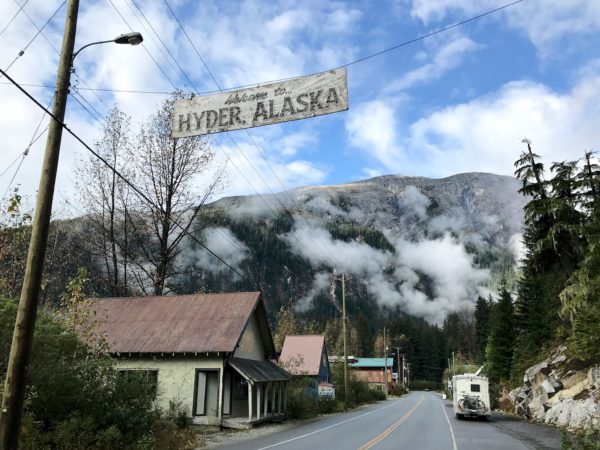
Hyder, AK (pop <80, even fewer in winter), is a short drive (or walk) over the US/Canada border from Stewart, BC. While it’s connected via road to Stewart, it is totally disconnected from the rest of Alaska. The nearest Alaskan towns are Ketchikan, 65 miles as the eagle flies or 160 water miles via ferry (oh wait, that stopped running in the 1990’s) or Skagway, a 699-mile drive. It began, like Stewart, as a gold-rush mining town, but US law enforcement was far away and the Canadian RCMP had no jurisdiction across the border, so… let’s just say opportunities for interesting exchanges of services were aplenty. As mining declined, the people who remained in Hyder made the best of its unique location, being the southernmost and easternmost point in Alaska you can drive to. And, standing anywhere in the one block of downtown Hyder, there are towering mountains in every direction. Tourism is the town’s major draw. In fact, Hyder now bills itself as ‘The friendliest ghost town in Alaska.’ After talking to a few locals, we agree. And for us, it’s the last town in Alaska we get to visit on this trip…
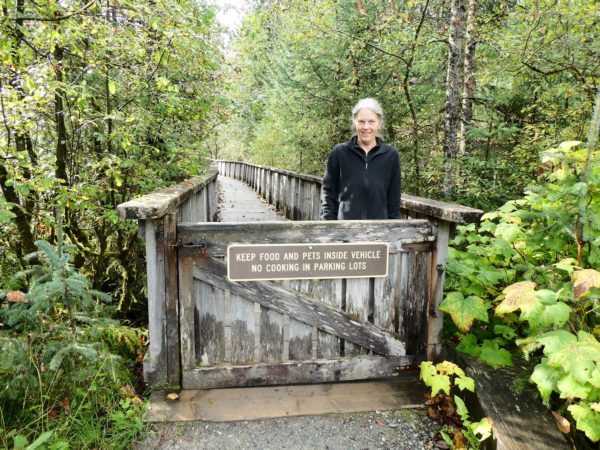
Just outside of Hyder is the Fish Creek Wildlife Observation Site. Salmon return to spawn in Fish Creek from June until September, and the local black and brown (grizzly) bear populations consider this their daily all-you-can-eat buffet. The US Forest Service keeps the bears wild and safely away from humans with a series of high, walled boardwalks that overlook the creek. It helps that the bears are much more interested in the fish than in the people watching them. Our visit in mid-September is late in the season for salmon spawning, so we saw (and smelled) many, many post-spawning (deceased) salmon, as well as a good number of pink and chum salmon still making their way upstream to spawn (alive!). We saw no bears at the bear watching location, though we did see 5 black bears along the road outside of town, including a momma and her twins.
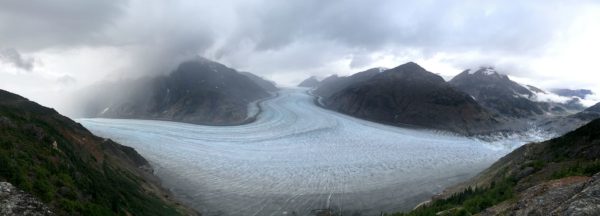
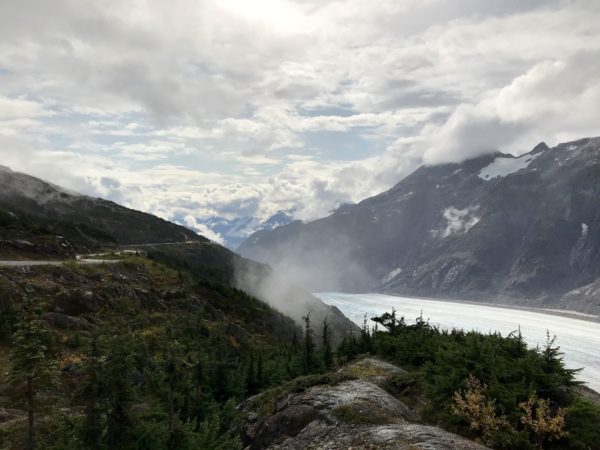
There’s an unpaved road that starts at the Fish Creek area and climbs out of Hyder – a road carved into the mountains and back into British Columbia that no one would build except a mining company and that few people would drive in an 8-meter (25-foot) RV. We had spectacular views overlooking the Salmon Glacier that turned to jaw-dropping from the summit viewpoint near the end of the road.
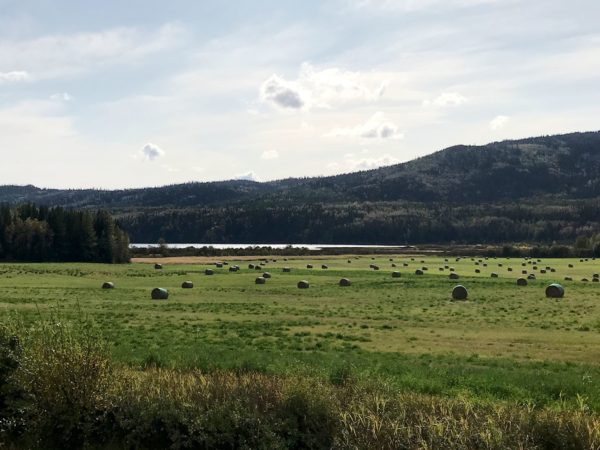
Two km (1.2 miles) after leaving the Cassiar and joining the Yellowhead Highway, we noticed yet another distinctive change: Cows. Hay. Grazing. There are a handful of cattle in Alaska, but these were sights we hadn’t seen for four months. We really are heading south!
For anyone who’s interested, more Cassiar Highway, Bear Glacier, Stewart , BC, Hyder, AK, wildlife viewing, Salmon Glacier and Yellowhead Highway pix…
Afterword…
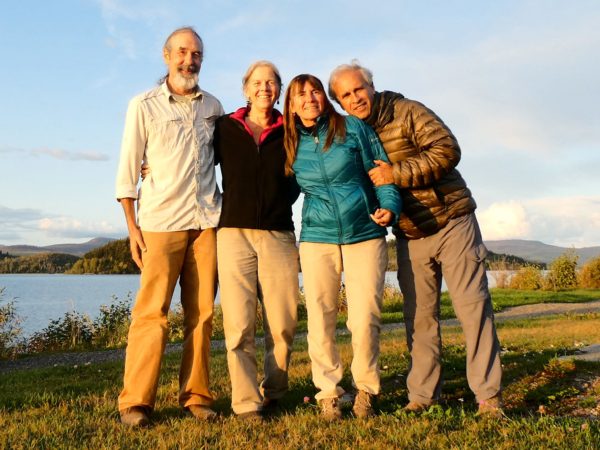
Sitting in a peaceful, lakeside campground in Fraser Lake, BC, we laughed as Dolores and Alejandro pulled up next to us, just in time for happy hour. We meet again!

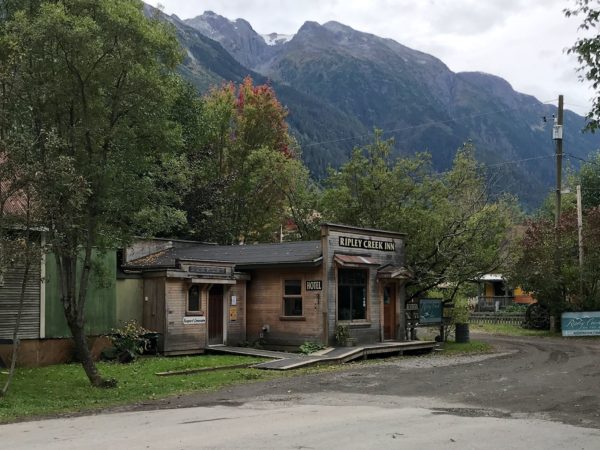
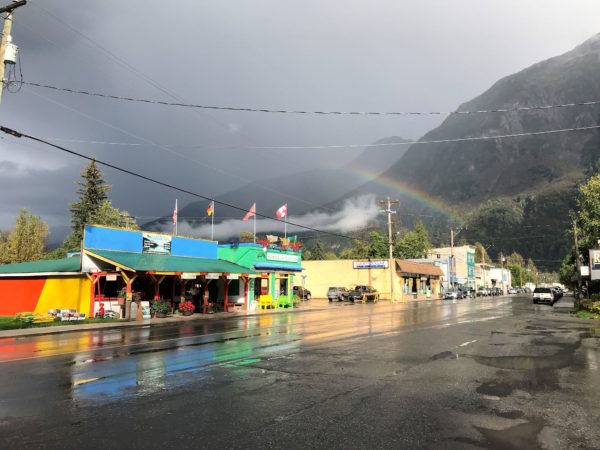
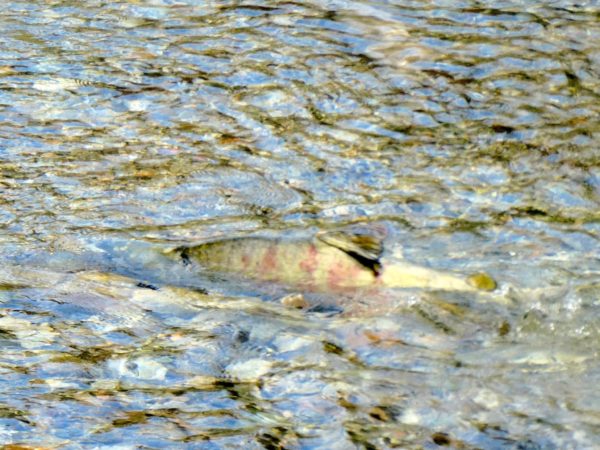
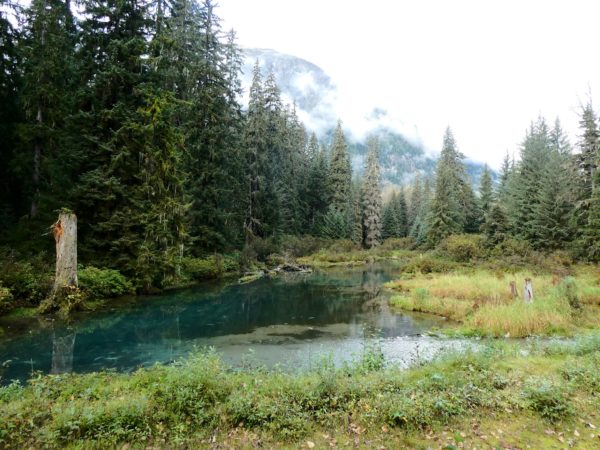
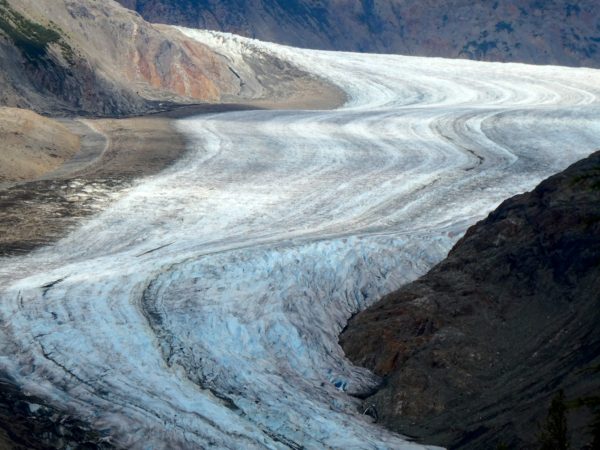
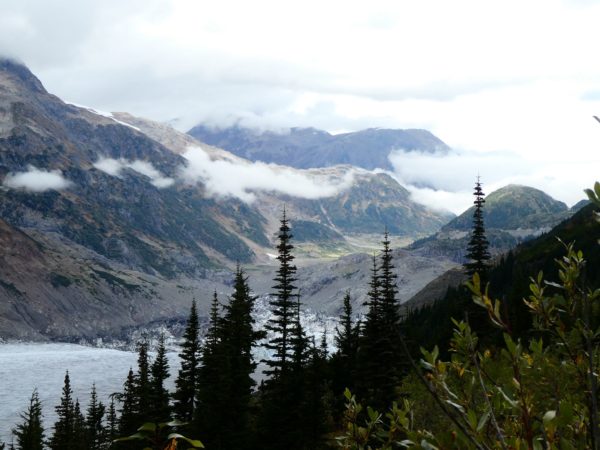
Hello! How nice reading about our surprising meetings. Four times is not casuality but similar ways of living. Hope meeting you again. Congratulations for the blog is wonderful and the pictures
Best regards for you and Doug
Thanks Dolores! I think you’re right. Our travel lifestyles are so similar… The places we choose to explore, how we learn about those places and their cultures, the pace we keep. Yes, hope to see you again down the road. Won’t be a surprise, yet we’ll still laugh and enjoy your company.
Hello Sue!!!! Yes we re going to meet again for sure. Now in Vancouver a wonderful city to share a cup of tea.
Best regards and roads for you both.
Dolores and Alejandro
Hi Dolores and Alejandro! So glad you mentioned you were in Vancouver. Turn outs, we were passing within 4km of your stop at the library… So glad we were able to get together again! Good tea. Great conversation! Enjoy the rest of your travels!